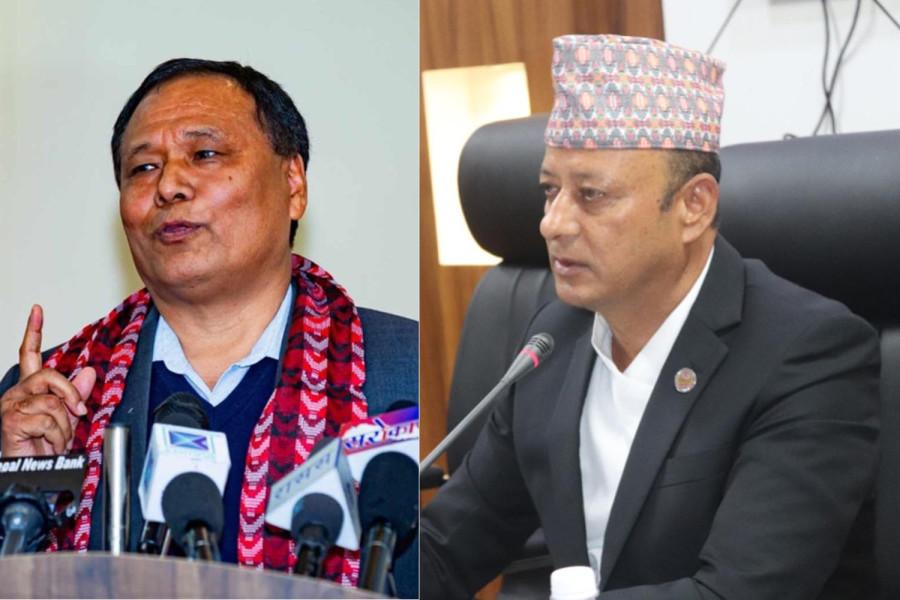National
Energy Minister Khadka hounds power utility chief with new clarification letter
Explanation sought over ‘poor performance’, transformer purchases, ‘lack of cooperation’.
Purushottam Poudel
Six months into the tenure of the Prime Minister KP Sharma Oli, the rift between the government and Kulman Ghising, the executive director of the Nepal Electricity Authority (NEA), shows signs of further escalation. On Monday, Minister for Energy, Water Resources and Irrigation Dipak Khadka sent Ghising a nine-point letter asking, “Why should you not be sacked from your position?”
The Ministry of Energy has sought clarification from Ghising on several issues including his alleged failure to provide details on transformer purchases, his ‘unbalanced responses’ to its earlier requests for clarification, and his ‘lack of cooperation’ with a government-formed inquiry committee.
Similarly, the letter mentions Ghising’s low marks in work performance.
According to Point 8 of the letter, Ghising will need to submit his clarification within seven days. The letter warns of further action against him if Ghising fails to supply a ‘satisfactory response.’
As he did earlier, Ghising is expected to send his response to the ministry this time as well. A close aide to Ghising told the Post that continuous tussle between the government and the NEA chief had demoralised the entire NEA administration.
On December 31, the Cabinet meeting approved the “Energy Development Roadmap-2024 Proposal” with a stated aim of generating 28,500 megawatts of electricity by 2035. The approval opens the door to various investment models for large-scale and new energy projects. However, an NEA official told the Post that the government has not shared the roadmap with the authority.
“The roadmap has paved the way for the development of both government-initiated and privately-invested hydropower projects,” an officer at the authority told the Post requesting anonymity as he is not authorised to speak to the media. “Even as the government has frequently written to the NEA chief seeking his clarification, it is yet to send a copy of the roadmap.”
“In this dry session, where is the discussion on managing the country’s electricity? How long will we rely on a third party to address the energy deficiency during the dry season, and what are our plans to use surplus energy in the wet season?” an official at the energy ministry said.
“For the past six months, the ministry and the NEA have been caught in an unproductive tussle,” the officer said.
On October 24, the authority decided to cut power to dozens of industrial firms with outstanding electricity bills. The firms have long refused to clear their bills despite losing a court case. However, citing the country’s sluggish economy, the government insisted on continuing power supply to these firms.
Following a Cabinet decision on November 10, power supply was restored to 28 of the defaulting firms on November 12. The Cabinet also set a 15-day deadline for the firms to clear their dues, but the firms ignored the deadline.
Despite this, the government prevented the NEA from taking further action against the defaulter firms. Instead, it formed a three-member committee led by Arvind Kumar Mishra to study billing disputes related to dedicated feeders and trunk lines used by dozens of industrial firms.
But the committee has yet to start working effectively even after over a month of its formation. The ministry also asked the authority to allocate funds for the committee’s salaries, operational costs, and vehicles.
The NEA has questioned the legality of the committee and said such committees should be established through the Electricity Regulatory Commission, not directly by the ministry.
During a December 19 board meeting, after Minister Khadka proposed allocating NEA funds for the committee’s operation, Executive Director Ghising and two other members Ratan Ayer and Bharat Acharya, wrote a note of dissent questioning the committee’s legality.
“In the board meeting, Ghising filed a note of dissent opposing the formation of a committee to study the Time of Day (ToD) meter,” an official privy to the development said.
High-ranking officials within the energy ministry have also questioned the legal basis of the committee formed by Minister Khadka.
“The committee was set up to investigate the tariffs charged by the NEA, but under which law was the committee formed? And on what basis will it operate?” another official at the energy ministry said, requesting anonymity. “There is no basis for the authority to provide TOD meter data to such a committee for a billing investigation.”




 7.12°C Kathmandu
7.12°C Kathmandu













